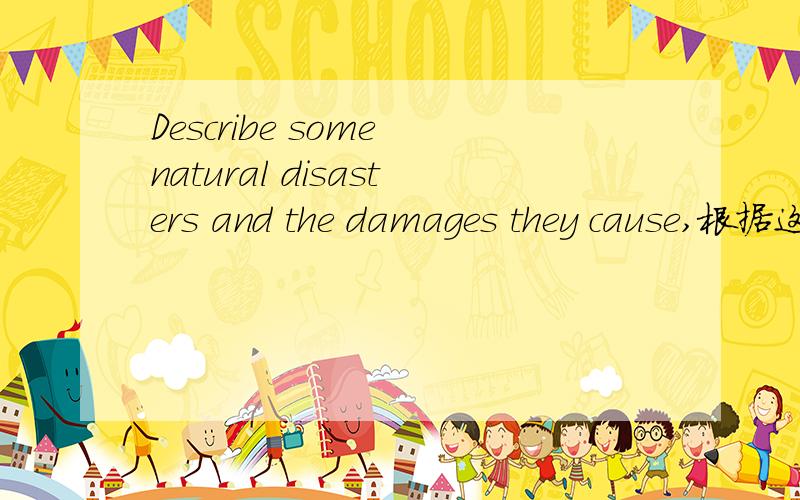Describe some natural disasters and the damages they cause,根据这个题目写一篇英语作文
来源:学生作业帮助网 编辑:作业帮 时间:2024/04/25 18:30:49

Describe some natural disasters and the damages they cause,根据这个题目写一篇英语作文
Describe some natural disasters and the damages they cause,根据这个题目写一篇英语作文
Describe some natural disasters and the damages they cause,根据这个题目写一篇英语作文
Natural Disasters In the past hundred years, there have heen frequent natural disasters, such as flood s, droughts , mud -rock flows, seismic sea waves, earthquakes, windstorms and the stretching of new deserts.
The disasters have killed millions upon millions of people, destroyed countless homes, and wiped out numerous pieces of fertile land. Now more and more people become aware that those disasters have much to do with what we have done to the earth. We have cut down too many trees in the forests,we have badly polluted the environment, we have shocked our own home-planet time and again with tremendously powerful explosions of nuclear bombs. As a result, climates have become abnormal, rainwater rushes down hillsides angrily, and the underground energy goes up to revenge itself on us.
The earth is our only home-planet. It is urgent for us to stop damaging it, and to do our best to protect it and make it a lovely place suitable to live in, for we have nowhere to go and survive except where we are now.
难点的
Human behavior triggers natural disasters
If a homeless man were standing on the corner of a street as you were passing by, screaming "The world is coming to an end!" would you believe him?
Movies set aside, most would try not to make eye contact and walk by swiftly muttering, "He's crazy."
But what if this "insane" man's predictions came true? What if a fire started in your own backyard because of a drought or if your entire neighborhood was wiped out by a terrible monsoon one night?
Global warming is no longer the problem of our future generations. It is our problem.
Rising sea levels due to melting glaciers; droughts, monsoons, wildfires and greenhouse gasses are all natural disasters that have come to be known as not-so-natural.
How is something we can't control not natural? Its simple- these actions have been on the rise because of the effect of our every day lives on Mother Nature.
Whether it's a citizen's daily commute, running their clothes through a dryer in the middle of the day, watering their lawn during winter or even the kind of light bulbs they use, they have a bigger impact on the environment then they are aware of.
In fact, the United States only makes up four percent of the world's population but is responsible for an alarming 22 percent of the world's greenhouse gas emissions.
Carbon dioxide (CO2) is the main culprit for our greenhouse gas emissions. Earth is designed to hold just enough CO2 to create a warm blanket, therefore allowing life to form.
With Americans pumping out millions of pounds of carbon every day with our gas-guzzling cars and ruthless energy use, Mother Nature was bound to lash back sometime.
There's always the skeptic who couldn't possibly make the connection between them driving their car to work everyday and the polar ice caps melting at alarming rates.
Anyone who's taken a science class in their lifetime knows that heat melts ice. The more carbon released into the atmosphere, causes more heat to be trapped which means glaciers act as ice in a glass on a summer day in the Valley of the Sun.
But what most people don't realize is how much carbon and even money they can save by carpooling with someone who is taking the same route. In a year, it can save 1,590 pounds of CO2 and hundreds of dollars.
Drastic climate changes aren't the only predictions in Earth's crystal ball.
Insect-born diseases such as malaria, dengue fever and encephalitis can be spread by mosquitoes and rodents who migrate to warmer areas.
According to the World Health Organization (WHO), climate change contributes to 150,000 extra deaths a year. With the climate gradually getting worse, this number can easily be doubled in the next 25 years.
Respiratory problems are also in the future due to high levels of CO2 favoring the growth of ragweed and other pollen producers. The amount of pollen produced rises with CO2 emissions and therefore causes more asthma and allergy attacks.